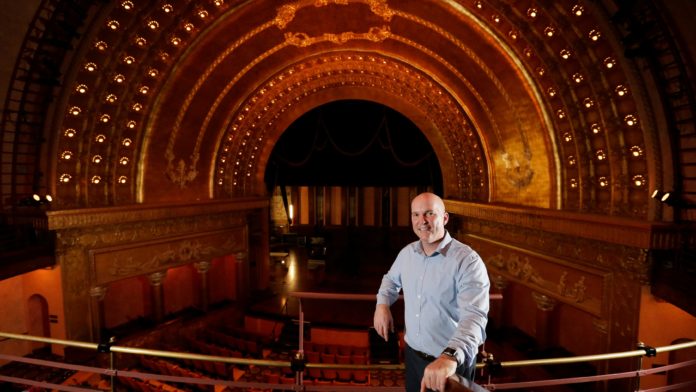In 1896, writer F. Scott Fitzgerald was born, abolitionist Harriet Beecher Stowe died and Ohio Republican governor William McKinley bested Democratic Party standard-bearer William Jennings Bryan for president. Women would not have the right to vote for another 24 years.
The world was a very different place 125 years ago, but one thing in Columbus has remained a constant: The Southern Theatre, then as now, has the best acoustics in town.
“You can whisper on the stage and it can be heard from the furthest row away,” said Jason Gay, the vice president of operations of the Columbus Association for the Performing Arts (CAPA), the current owner and operator of what is the oldest extant theater in Greater Columbus.

The Southern Theatre, at 21 E. Main St., is celebrating a birthday this week: The venue — unique among still-standing performing-arts venues for being attached to a hotel, what is now the Westin Great Southern Hotel — first raised its curtain on Sept. 21, 1896.
CAPA will host a self-guided free open house from 1 to 4 p.m. on Sept. 26.
Remnant of Columbus’ grand theater district
The Southern is something of the last theater standing among what was once a vibrant theater district, said Columbus historian Ed Lentz.
“The Southern is part of that district that basically centered around Broad and High,” Lentz said. “There were a huge number of theaters running down Broad Street towards the river.”
During a period in which electricity was just starting to come to Columbus, the Southern stood out for being electrified; other theaters then in operation, a number of which burned down, used gas jets to provide light.
“The builders deliberately wanted to build something that they could claim was fireproof,” Gay said, pointing to the materials chosen by architectural firm Dauben, Krumm and Riebel.
“They used steel and brick construction, and they tried to avoid wood,” Gay said.
Heyday of the Southern Theatre
Of course, the stars who took to the stage at the Southern burned brightly.
Leading talents took bows during the theater’s heyday: According to CAPA, notable names to have made appearances included comedian W.C. Fields, composer John Philip Sousa (said to have logged 10 appearances), dancer Isadora Duncan and the acting royalty of John, Lionel and Ethel Barrymore.

“We’ve got stories of really major productions being shown onstage there — ‘Ben-Hur’ being the biggest, with two chariots with horses galloping across the stage on a treadmill,” Gay said.
By the 1920s, the Downtown theater district no longer had a captive audience.
“The coming of inexpensive automobiles, combined with a good roads movement, mean that people can go a lot of different places other than Downtown,” Lentz said.
Plus, performing-arts venues such as the Southern faced competition from radio and the movies; the Ohio Theatre, originally a Loew’s movie palace, opened in 1928. (In 1914, in a bid to capitalize on the new moving-picture art form, a movie screen and projector were installed in the Southern; both were removed when CAPA renovated the theater in the 1990s.)
Live performances pause
Hard times came for the Southern: CAPA said that the theater was the site of community events, such as graduation ceremonies for the Columbus School for Girls, before being acquired by the North American Broadcasting Company, the owner of WMNI (920 AM) radio station, which produced and broadcast its “Country Cavalcade” program there. Live performances ended in 1979.

Then, in 1982, developers Bill and Barbara Bonner and David and Vicki Brooks bought the theater and hotel, according to Tom Betti and Doreen Sauer’s book “Historic Hotels of Columbus.” Four years later, the theater — by then in significant disrepair with the stage damaged and seats torn out — was donated to CAPA.
“We could tell, even in its completely disheveled state, that the bones of it would be magical for audiences and artists alike,” said Douglas Kridler, the then-president of CAPA and current president of the Columbus Foundation.
CAPA officials recognized that multiple local organizations needed a venue more intimate than the Ohio Theatre. The Southern currently seats 933 (less than when it opened) — a far cry from the Ohio’s 2,791 seats.
“To have a chamber orchestra, the chamber was important,” said Timothy Russell, the co-founder of the ProMusica Chamber Orchestra, which had not had had a stable, dedicated venue in which to perform since its founding in 1978.
‘This is just an awesome place’
A $10 million renovation effort — with $3.9 million coming from the state of Ohio — commenced in 1996 with the goal of bringing the building into the 20th century, with updates to lighting, sound, air and heating systems and other mechanicals, while preserving its historical character. The remainder of the funds, according to CAPA, came from businesses, local and national foundations, and over 250 individual donors.
“You still have the feel that you’re in this late-1800s space,” said Gay, pointing to efforts to match the original paint colors and recreating the Dutch leaf adorning the concentric arches that loom over audience members and from which hang 204 lightbulbs — a signature element of the theater that got the attention of country star Alison Krauss, among the first performers booked after the theater reopened in September 1998.
“Between songs, (Krauss) paused and looked up and said, ‘This is just an awesome place. It’s like performing in a giant wedding cake,’” Kridler said.
Southern Theatre’s role in Columbus
Today, the Southern not only hosts touring acts but also serves as home base for several arts groups that offer most of their concerts there, including ProMusica, Opera Columbus and the Columbus Jazz Orchestra.
“It’s probably my favorite hall,” said CJO Artistic Director Byron Stripling. “It has the majesty of a concert hall but yet the intimacy of a jazz club. … I can actually see faces, almost to the back.”
Arts leaders look back on the history of the Southern with a sense of appreciation.
“It did raise the profile of not only the arts for Columbus Ohio, but raised the profile of Columbus, Ohio,” Russell said. “It truly is a magnificent theater.”
Open house at a glance
The Southern Theatre’s 125th Birthday Celebration Open House will take place from 1 to 4 p.m. Sept. 26 at 21 E. Main St. The event is free; masks are required. For more information, visit capa.com.
Southern Theatre history
• Opened on Sept. 21, 1896.
• Columbus’ oldest existing theatre.
• Columbus’ only remaining double-balcony theatre.
• One of only 250 theatres in the US built in the 19th century that is still standing.
• One of the first fully electrified public buildings in Columbus. (It had its own power generator in the basement.)
• Before the Southern was built, theatres in Columbus were wooden structures that were lit with gas jets. Within a four-year period prior to the Southern being built, three of these older theatres were destroyed by fire.
• The “modern” construction of the Southern included iron, steel, brick, and stone along with thousands of red clay tiles. The theatre also used electric light bulbs instead of gas jets. These things helped to make the theatre “fireproof,” and helped it last for more than 100 years.
When it first opened
• Columbus was known as the Buggy Capitol of America (carriage manufacturing was big business here).
• Shortly after the Southern opened, as the city got its first power station for electricity, Columbus was called the City of Arches because of the large, electrified arches that lined the main streets of downtown.
• Among the businesses active on the southern part of downtown were the Buggy Works, several brewing companies, and Lazarus Department Store.
• The theatre was built next to a hotel (The Great Southern “Fireproof” Hotel and Opera House). It was paid for by a group of downtown businessmen (including the Lazarus family) who wanted to ensure activity on the southern part of downtown by adding an “entertainment and business center.”
• Many 19th century theatres were built next to hotels so visitors could carry on business meetings, eat in the hotel restaurant, go to the theatre for entertainment, and sleep. Entertainers would also stay in the hotels attached to these theatres.
Source: CAPA
tonguetteauthor2@aol.com









